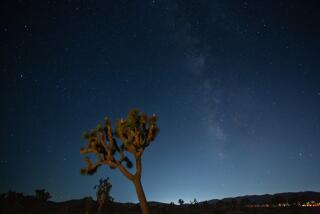Through the Shutter : Getting a Focus on Visual Delights of East Africa
- Share via
Having made more than 15 combined trips to East Africa, we consider it one of the most visually exciting destinations in the world.
Today the visitor can “bring ‘em back alive” on film or videotape. Experience has taught us what one needs to know in planning for a photo tour of Kenya and we want to share that knowledge with you.
Starting with the basics: Carry two camera bodies and at least two zoom lenses, one ranging from about 28 to 90mm and the other from about 70 to 210mm. More advanced amateurs may also want a stronger telephoto such as 300 or 400mm for some game shots. In many of the game preserves it is often possible for safari vehicles to get close enough to the animals to allow for good pictures with a normal lens.
We strongly recommend slide film as opposed to print film. (Our choice is Kodachrome 64 for consistent high quality and good color saturation.) With color negative, print film, it is necessary to make a print of every frame exposed to even see the results. That can be very expensive when one is taking hundreds or even thousands of pictures on a three-week trip.
People on safari tend to overshoot, especially on game runs, because they never know when or if they will see that animal again. Naturally they will try for a picture, even when the animal is too far away to show up well in the frame.
Selecting Prints
It is possible to make excellent prints from slides and with Kodachrome you can see the positive image before deciding if you really want a print of a certain picture.
Carry your film with you and be sure to take an adequate number of rolls. Film is expensive in Africa.
Your film needs will depend on how you shoot and whether you bracket your exposures. On a safari, film is your least expensive commodity and you may never get the chance to go back to Africa again. We carry at least 100 rolls on each safari and put it in film shield bags in our luggage.
Many visitors go to Kenya expecting to get interesting pictures of the natives and that is possible but is not easy, and in some places can even be dangerous. Most Kenyans do not like to be photographed and that is true of the Masai tribe in particular.
Originally their opposition was based on a superstitious fear of cameras, but in more recent years they have come to realize that posing for a camera has a commercial value and some will gladly pose for money. I strongly advise against taking any pictures of the Masai without their clear agreement.
Include a visit to Mayer’s Ranch a short distance from Nairobi. This cattle ranch has a Masai village on the property and they stage native dances. The price of admission gives the visitor carte blanche to take pictures of the dancers and of the village at no additional cost.
The village is authentic and it is possible to get some stunning pictures of the Masai women with their vivid wedding beads and stretched ear lobes. Visits to other villages can be arranged by payment to the village chief through your driver-guides, but we have found through trial and error that Mayer’s Ranch is far more satisfactory.
Most traveling and photography in East Africa is done from a safari vehicle and with a driver-guide. The most popular type of vehicle is the mini-bus with a pop-up roof that carries an average of six people (each with a window seat) and the driver.
It is possible to book a tour after arriving in Africa, but one does not always have a choice of the type of tour and desired itinerary at the last moment.
We do not recommend driving the game parks on your own with a rental car. It can be both dangerous and disappointing. The guides know the parks and can find the animals. They have knowledge that takes years to accumulate.
Selecting Best Tour
The first-time visitor to Africa with a strong interest in photography should select a tour with an itinerary that includes the best photographic opportunities. Kenya is filled with game parks, lakes, recreational areas and beaches of great beauty, but obviously some are better than others for photography.
Four Stars to One
The safari circuit includes some familiar names and sites and, based on our assignments and experiences, we have rated them from four stars down to one for photographic appeal and made comments on the picture opportunities:
--The Masai Mara : This vast plain near the border with Tanzania is the northern extension of the Serengeti and is host to a multitude of birds and animals that live in a delicate ecological balance.
--Balloon Safaris : At Masai Mara you may book hot-air balloon rides that drift on the gentle morning wind over the herds of animals so you can take aerial pictures. (The cost is about U.S. $200. Book well in advance.)
--Mount Kenya Safari Club : This impressive lodge at the foot of Mt. Kenya is considered the most luxurious hotel in all Africa and no photographer should miss spending at least one night there.
--Treetops : This historic game-viewing lodge, originally built in the branches of a large tree, does not offer much in the way of picture-taking opportunities because most of the game gathers at night. An interesting and charming place to stay, but not for pictures.
--Amboseli : Amboseli in the shade of Mount Kilimanjaro is in the heart of Hemingway country and it can be a place of memorable images. Kilimanjaro is most often clear in the early morning or just before sunset.
--Mombasa : This attractive beach resort offers a white-sand beach in a tropical setting and an old Arab city with a lot of charm, but has no animals. You can capture some compelling Winslow Homer-type images here.
--Nairobi : A bustling cosmopolitan city with attractive hotels and fine restaurants.
We have left out some photogenic and worthwhile destinations in Kenya, but this rates some of the highlights.
More to Read
Sign up for The Wild
We’ll help you find the best places to hike, bike and run, as well as the perfect silent spots for meditation and yoga.
You may occasionally receive promotional content from the Los Angeles Times.






